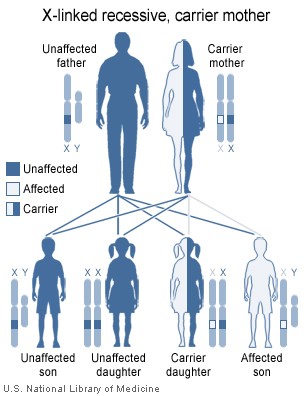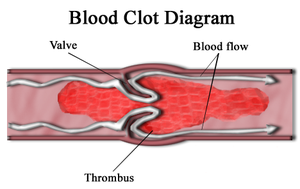29.8A: Hemostasis Disorders
- Page ID
- 8355
The most common blood disorders involve defects in the amount or activity of factors involved in coagulation.
- Differentiate among the hemostasis disorders of Von Willebran disease, hemophilia, and factor V Leiden thrombophilia
Key Points
- Von Willebrand disease is the most common inherited bleeding disorder. People with type 1 and type 2 von Willebrand disease may have mild-to-moderate bleeding symptoms, while those with type 3 can have severe bleeding episodes.
- Hemophilia is a disease where there is a low level of, or are no, blood proteins important for clotting, causing an inability to produce blood clots. There are two types: Type A, which is a deficiency in factor VIII, and Type B, also known as Christmas disease, which is a deficiency in factor IX.
- The opposite of hemophilia is Factor V Leiden thrombophilia, a disorder of human factor V blood protein that causes a hypercoagulability disorder or overactive clotting resulting in dangerous blood clots.
- In sickle- cell disease, red blood cells undergo a change in shape upon deoxygenation because of polymerization of the abnormal sickle hemoglobin.
- Polycythemia is a condition in which there is a net increase in the total circulating erythrocyte (red blood cell).
- Leukemia is a cancer of the blood or bone marrow characterized by an abnormal proliferation of blood cells, usually white blood cells (leukocytes).
Key Terms
- Hemophilia: A group of hereditary genetic disorders that impair the body’s ability to control blood clotting or coagulation, which is used to stop bleeding when a blood vessel is broken.
- coagulation: The process by which blood forms solid clots.
- thrombophilia: The tendency to develop thrombosis (blood clots) due to an abnormality in the system of coagulation.
The most common blood disorders, Von Willebrand disease, hemophilia, and Factor V Leiden thrombophilia, all involve defects in the amount or activity of factors involved in coagulation.
Von Willebrand Disease
Von Willebrand disease is the most common inherited bleeding disorder, and it affects both men and women equally. Von Willebrand disease is similar to hemophilia in that it involves a deficiency in the ability of blood to clot properly. Those affected by von Willebrand disease will have low levels of von Willebrand factor, a protein that helps the blood to clot, and/or their von Willebrand factor does not work properly.
There are three types of von Willebrand disease: type 1, type 2, and type 3. People with type 1 and type 2 von Willebrand disease may have the following mild-to-moderate bleeding symptoms: easy bruising, nosebleeds, bleeding from the gums after a dental procedure, heavy menstrual bleeding in women, blood in their stools or urine, and excessive bleeding after a cut or other accident or surgery.
Type 1 von Willebrand disease is the mildest and most common form of the disease. In this type of disease, there is a low level of von Willebrand factor. The level of factor VIII, another protein involved in clotting, may also be lower than normal. About 3 out of 4 people diagnosed with von Willebrand disease have type 1.
Type 2 von Willebrand disease has four subtypes and ranges from mild to moderate in severity. In this type of disease, there is a defect in von Willebrand factor resulting in improper activity.
Type 3 von Willebrand disease is very rare and is the most severe form. In this type of disease, individuals usually do not produce von Willebrand factor and have very low levels of factor VIII. Symptoms of type 3 von Willebrand disease might include any of the symptoms of types 1 and 2 and also include severe bleeding episodes for no reason, which can be life threatening if not treated immediately. Bleeding into soft tissues or joints causing severe pain and swelling is another symptom.
Many people with von Willebrand disease do not require treatment to manage the disease. However, if treatment is necessary, it may include a range of different interventions depending on the severity. These involve medicine to increase the level of von Willebrand factor in the blood, medicine to prevent the breakdown of clots, medicine to control heavy menstrual bleeding in women, or injection of clotting factor concentrates.
Hemophilia
Hemophilia is a disease where there is a low levels of, or none, of a blood protein important for clotting, causing an inability to produce blood clots. There are two types of hemophilia: Type A, which is a deficiency in factor VIII, and Type B, also known as Christmas disease, which is a deficiency in factor IX. Since people with hemophilia do not have the ability to make blood clots, even a small cut can result in severe bleeding, or the smallest bump or jar to the body could cause severe bruising that does not heal for months. Hemophilia is a recessive, sex-linked inheritable disorder, which is more common in men than women. Treatment typically involves replacement of the missing blood factors through blood transfusions.

Inheritance of X-linked Recessive Traits: Hemophilia is an x-linked recessive inheritable disorder.
Since the 1980s, the primary leading cause of death of people with severe hemophilia has shifted from hemorrhage to HIV/AIDS acquired through treatment with contaminated blood products. The second leading cause of death related to severe hemophilia complications is intracranial hemorrhage, which today accounts for one-third of all deaths of patients with hemophilia.
Factor V Leiden Thrombophilia
The opposite of hemophilia, is Factor V Leiden thrombophilia, a disorder of human factor V blood protein that causes a hypercoagulability disorder, or, overactive clotting, resulting in dangerous blood clots. In this disorder, the Leiden variant of factor V cannot be inactivated by activated protein C, as it would be in a person with normal factor V, resulting in excess clotting. Factor V Leiden is the most common hereditary hypercoagulability disorder among Eurasians. Those that have it are at a slightly higher risk of developing blood clots than those without. Those that test positive for factor V should avoid oral contraceptives, obesity, smoking, and high blood pressure to reduce their risk of developing blood clots.

Blood clot diagram.: Blood clot diagram.

